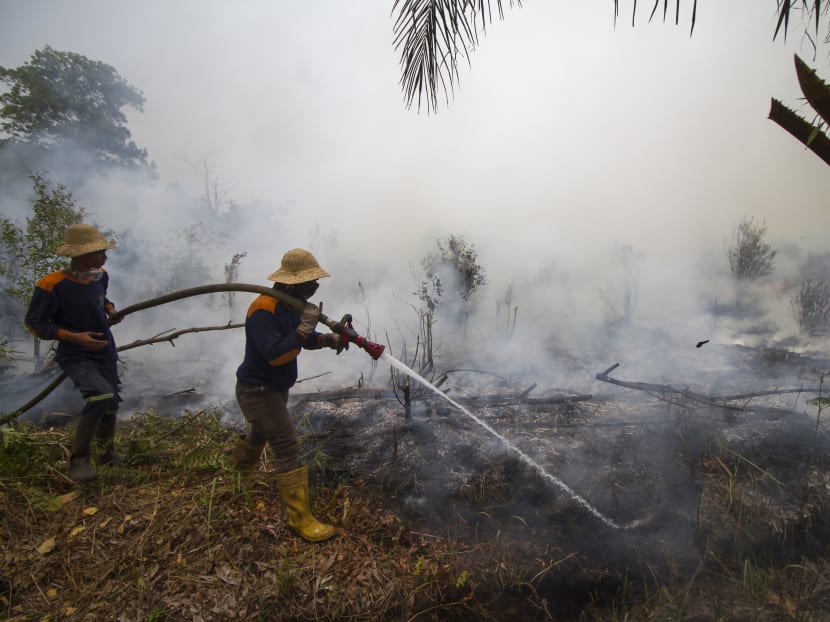Indonesia has not met target to restore peatlands that is key to prevent forest fires and haze. Here’s what it can do
Despite falling short of its target, Indonesia’s Peatland Restoration Agency is likely to continue its work to rehabilitate the country’s peatland as part of the government’s attempts to meet its emission commitments.

Firefighters extinguish a peatland fire in Palangkaraya, Central Kalimantan on Sept 12, 2019. Indonesian citizens, and those of neighbouring Southeast Asian countries, have long suffered recurring haze pollution from peatland fires in Indonesia.
Despite falling short of its target, Indonesia’s Peatland Restoration Agency is likely to continue its work to rehabilitate the country’s peatland as part of the government’s attempts to meet its emission commitments.
Indonesian Minister of Environment and Forestry Siti Nurbaya announced the agency’s tenure, ending on Dec 31, would likely be extended for the next four years. That’s despite the agency achieving only 45 per cent of the restoration target under the previous contract.
Restoring peatlands is important for Indonesia to avoid forest fires. Indonesian citizens, and those of neighbouring Southeast Asian countries, have long suffered recurring haze pollution from peatland fires in Indonesia.
Emissions from these biomass wildfires have contributed substantially to carbon dioxide and other greenhouse gases in the atmosphere.
Established in 2016, the agency was mandated to rehabilitate 2.6 million hectares of drained and degraded peatlands in seven provinces by 2020. It has restored only 45 per cent of the target so far.
Our research and interviews with stakeholders and policy analysis have identified various constraints hindering the agency’s restoration work since 2016.
We would recommend two priorities for action to ensure the agency’s success in its next restoration projects.
TENSIONS AND TECHNICAL ISSUES
As a temporary agency with limited funding, legal and political power, the Peatland Restoration Agency has often struggled to implement its programs.
One reason is that it has no legal authority to work in private plantations and forest areas.
This poses a substantial obstacle because 1.7 million hectares of the total of 2.6 million hectares of degraded peatland is inside forest areas and palm oil concessions. These fall under the jurisdiction of the Ministry of Environment and Forestry.
This fragmented and overlapping legal authority and responsibility for peatlands has resulted in rivalries and tensions between the agency and the ministry.
At times, the ministry has been hesitant to share with the agency’s officials access and information on the progress of peatland restoration projects inside forestry concessions.
These strained relations have slowed progress on peatland restoration and created confusion among landholders.
On technical issues, the agency also struggled at first to develop a comprehensive plan for peatland restoration due to lack of image data from the fields.
The Ministry of Environment and Forestry was tasked to produce the data in the form of maps. It issued these at relatively low resolution (a scale of 1:250.000), too low for operational use.
Therefore, the agency has tried to produce an extensive peatland inventory and map the parameters of peatland hydrological units (PHUs) in seven provinces at a finer scale. These units are the administrative scale used to manage peatlands bounded by rivers and other ecologically important water bodies.
Despite these setbacks, the agency managed to implement its 3R approach — rewetting (reflooding dry peatland), revegetation (planting endemic and adaptive trees) and revitalisation (alternative community livelihoods) — to restore drained and degraded peatlands.
FUTURE PRIORITIES
We identify two priority areas where the agency could build on its existing capacities for the next term:
1. Community engagement
The agency’s flagship Peat Care Village Program has been gaining support from communities for peatland restoration.
The program treats farmers as partners in various conservation and development activities within the PHUs.
Several farmer groups in Riau Province have successfully cultivated adaptive crops on peatlands and avoided slash-and-burn land-clearance methods after attending the agency’s Peatland Field School.
There are over 600 Peat Care Villages in seven provinces: Riau, Jambi, South Sumatra, West Kalimantan, Central Kalimantan, South Kalimantan and Papua.
This program inspired other initiatives, such as the Fire Care Community, Fire Care Village and the Integrated Forestry and Farming System.
The first two are community-based forest fire prevention programs. The latter aims to integrate fire-prevention strategies with local farming systems.
These initiatives encourage gendered and intergenerational inclusion, while providing a basis for collective environmental activities and resource dispute resolution.
They also provide a basis for future collaborations between large plantation owners and small farmers.
Multi-stakeholder collaborations are important for sharing knowledge, technologies and dam infrastructures, all of which are crucial for protecting and developing peatlands sustainably.
2. Monitoring
The agency has developed a simple interface application called the Peatland Restoration Information and Monitoring System (Prims) to monitor its restoration progress in real time.
It helps to identify areas requiring improved interventions. It also provides insights into multi-stakeholder collaborations in specific programs such as reforestation and building dams to resaturate drained peatlands.
The Prims could democratise peatland restoration governance and build transparency in the monitoring of restoration activities.
For example, journalists could use Prims as a verification tool when reporting peatland fire locations.
For civil society organisations, Prims can also be a savvy device to monitor illegal opening of peatlands.
THE WAY FORWARD
The agency needs the support of all peatland stakeholders.
It has already gained support from peatland communities and small farmers over the past five years. In August 2020, almost 4,000 people signed a petition asking Indonesian President Joko Widodo to extend BRG’s tenure.
However, it has been less successful in obtaining support from key government agencies and state officials under pressure from vested interests in lucrative plantations like oil palm and acacia. The peatland protection agenda is seen as a barrier to the development of monoculture plantation.
This next term will be President Jokowi’s final opportunity to prove his commitment to protect and rehabilitate Indonesia’s remaining peatlands while at the same time contributing to climate change mitigation. THE CONVERSATION

ABOUT THE AUTHOR:
Rini Astuti is a research fellow at National University of Singapore. David Taylor is a professor at National University of Singapore. Michelle Ann Miller is a senior research fellow at the National University of Singapore.









